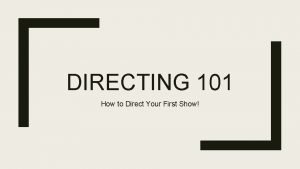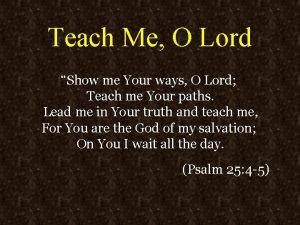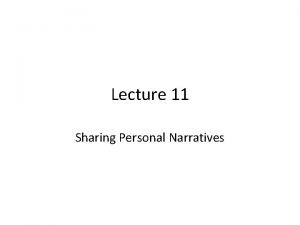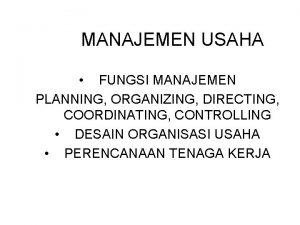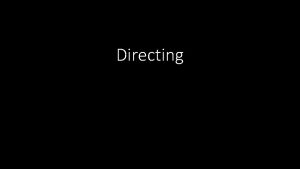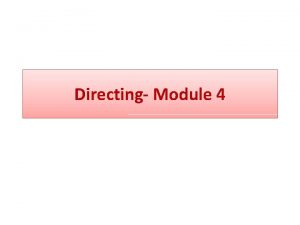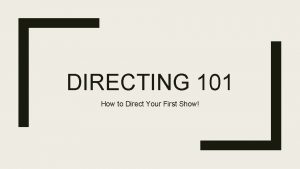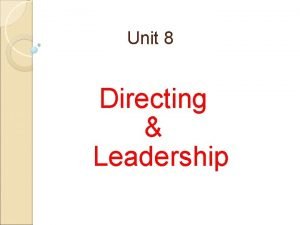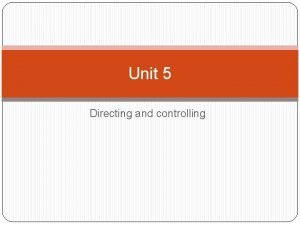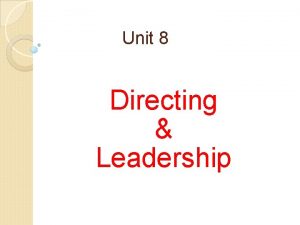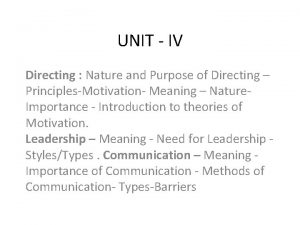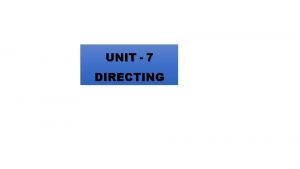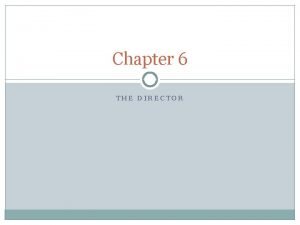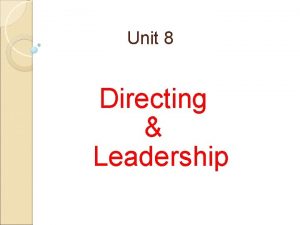DIRECTING 101 How to Direct Your First Show


















- Slides: 18

DIRECTING 101 How to Direct Your First Show!

Pick Your Show!! ■ You’ve done this! Your proposal to your administrator has been approved and you are off to the races! Go you! ■ Be sure to take ALL aspects we talked about into consideration when choosing your show. This step is likely the MOST vital step to the success of your show. Do NOT fall into the trap of simply choosing your favorite show. It may be a great show but it may not fit your group.

Schedule and Advertise Auditions! ■ Your audition process can make or break your show. You MUST highly advertise your auditions. BE OBNOXIOUS!! The more people to come out, the better! Do not just appeal to those interested in theater already. Appeal to those who are looking to try something new! ■ Some FULL PROOF Advertising Tricks! – – Posters! Like EVERYWHERE!!!! If you walk for more than 2 minutes without seeing a poster, you are not advertising enough!!! Morning Announcements! Utilize this if you have it! Be welcome NOT intimidating! Let people know that all kinds of theater levels are welcome! Do not advertise that the production is looking for “skilled or experienced” actors for the show! Say something like, ”looking for fun and open minded people who are willing to learn!” That MUCH less intimidating! Do NOT make auditions too hard! Make it SIMPLE! If you require too much prep from the actors, you will likely loose people who feel unprepared. They may even be ready to go in your eyes but they become self conscious and give up! Consider just asking for a monologue and or 16 bars of a song of their choice! They will do the rest

Auditions!! ■ Rule #1 of Auditions!!!! DO NOT GO INTO AUDITIONS WITH A PRE-CONCEIVED CAST IN YOUR HEAD!!!! Keep an open mind and consider ALL auditions for each role! This is only fair to all those auditioning and it will give your best cast result! The best auditions are full of surprises. ■ Forms, Forms!!!! USE them!!!! Trust me, you will want auditions to go quickly and efficiently. If they do not, you will NOT be a happy camper after the 4 th hour of hearing monologues. Have the auditionees fill out an info form before auditions so you do not have to ask as many questions and you have the info right in front of you! ■ Break the tension! If the actor is properly trained, they will arrive in the audition room promptly and professionally. This is GREAT but break the tension a bit and ask the actor a question or two to break the ice before they audition. It also allows you to see more of the genuine personality of the actor. ■ Do NOT rush the cast list! Take your time and consider several combinations! Consider time commitment and past work with the actor! Were they professional in the last play? Did they show up on time? Will they take this seriously? I take a committed actor over a talented actor EVERY time!

Posting your Cast List! (A. K. A. Throwing A Live Grenade…) ■ Anddddd here is probably the MOST emotionally draining part of the show for a director. Feelings can get hurt and people you are about are disappointed. Its NOT fun but it has to be done. Best advice? Stay professional and STICK TO YOUR DECISION!! You chose this cast for a reason and you need to stick by it. Do not discuss auditions of other cast members with someone in the show. Tell them “we put you in this role because we felt it is where you will best fit into the show’s success!” ■ Post the Cast List on a Friday! This allows the cast to not see each other for a weekend before rehearsals to cool down and think about their commitment to the show. It also gives individuals time to think about their roles. For example, if a cast member says they quit because they didn’t want that role, tell them you do not accept quitting until Monday. You would be surprised how many change their mind after a weekend of thinking it over.

So now you have a cast!! Pass out your schedules! -WHERE TO BEGIN? !? !? ! This is one of the hardest challenges I ran into as a first time director. BUT luckily, there is a formula!! It’s a great idea to pass out your rehearsal schedule before auditions so actors know what dates they are expected to be at BUT make sure you make the students aware that these rehearsals are subject to change as the show progresses and we find out what scenes need more attention. Formula of a Successful Rehearsal Schedule Length of Show (# of minutes) = Hours of Rehearsal / 10 -12 Weeks 1 -6 – 3 rehearsals a week Week 7 -8 – 4 rehearsals a week Week 9 -10 – Everyday + 1 Tech Saturday (8 -10 hours) Show Week – Monday and Tuesday Dress Rehearsals Wednesday – Press Dress Thursday – Final Dress (Invite Faculty or Nursing Homes!) Friday and Saturday – Performances

Week 1 – Read Through Week!! ■ Read throughs only!!! Make sure you stick to this. It is extremely tempting to start putting the actors up on stage and start directing the around. DO NOT GIVE IN!!! The read through process is super vital to the success of the show. If you skip this process, the blocking stage will take 30 bajillion times longer because the actor will not know what their role in the scene or the purpose of the scene in the show as a whole. You will have to tell them EVERY action. Actors are (mostly) intelligent!!! If they know the vital makeup of their scene, they will use their instincts and practically block it themselves. ■ Combine these read throughs with some super awesome social opportunities like movie nights and theater games at each rehearsal to allow the cast to get to know each other and start bonding as a cast.

Week 2 – Begin Blocking! ■ What is Blocking? ■ The Do’s and Don’ts of Blocking – DO Make sure you study the scene before blocking! USE STAGE CUES – DO NOT give the actors direction on the first run through! Let them use their instincts! This is a great learning opportunity for the actor. You are there to guide, NOT direct every movement. – DO make sure that you recognize the primary characters in the scene and prioritize! If someone does not speak in the scene but is simply there for atmosphere ex. Townspeople, place them upstage! They do not need to be front and center. Make it easy for the audience to know where to look!

The Art of Stage Blocking ■ http: //dictionary. tdf. org/blocking/ ■ Blocking – (n. ) – the positioning and movement of the characters to tell the story in visual terms. ■ “Proper Blocking should tell the story clearly to a deaf man!!” ■ Blocking is to tell aspects like the dramatic relationship, the character’s wants, what he/she feels, what stands in the way, and how is the conflict presently resolving.

Weak Movements, Strong Movements, and Relative Positioning ■ Blocking is generally broken up into 3 categories. Weak movements, strong movements, and relative positioning. ■ These three categories are what should drive your intent for your blocking. Ask yourself, how does the character feel at the moment? How would the character react to this line? How does a character feel about this other character or object? ■ MAKE YOUR BLOCKING PURPOSEFUL!!!!

Weak/Failing Movements ■ The purpose of a weak movement is to show that your character is uncomfortable or unsure of something. These movements are extremely useful when trying to convey your character’s attitude towards something or someone. ■ These movements are used to show your characters is uncertain, lacking confidence, hesitant, not in control, reactionary, intimidated, and regressive. ■ Examples of weak movements… – Stepping backwards, slouching, placing the weight on your back foot, sitting down, lowering the arm, walking backward, or turning around and walking away from something.

Strong/Winning Movements ■ The purpose of strong/winning movements is to show that the actor is confident in their dealings. These movements are extremely useful when showing that a character feels strongly about something whether it be happiness or anger etc. ■ Examples of Strong/Winning Movements are rising from a chair, straightening up, placing weight on the forward foot, raising an arm, or walking forward. ■ Strong movements show a confident, direct, controlled, active role, good eye focus and control, definite goals or wants, aggressive, assertive, strong speech patterns.

Stage Orientation Remember this?

Stage Directions – Weak or Strong? 1 – Strongest of Set 3 – Weakest of Set

Levels – The Actor’s Elevation ■ Levels are the elevation of the actor above the stage floor. The weakest might be lying on the floor, next sitting on the floor, then sitting in a chair, sitting on a chair’s arm, standing on one step, two steps, and so on until the actor reaches the top of a stairway or high platform. Ordinarily, the higher the level of the character, the stronger his position. ■ Example Time!!!!

Body Positions – Strong ■ Full Front Position - In the Full Front, the actor faces the audience or camera and is considered to be the strongest of the body positions. Full Back Position - The Full Back position has the actor standing with his/her back to the audience, usually for a brief period. This body position is usually used for dramatic effect. ■ One Quarter Front - the one-quarter front position, the body is turned almost quarter away from the audience either facing slightly left or right. Being an open (strong) position, it is the most frequently used. The actor still remembers to cheat out in this position.

Body Positions – Weak ■ Profile Position – When an Actor is turn a quarter turn to the right or left and is showing the audience their profile. Also referred to as the half position, this body position is not particularly strong. In theatre, the actor looking to his right is said to be in “right profile” and the left side of the face and body is open to the audience. ■ Three-Quarter Back Position - In the Three-Quarter Back Position, the actor turns his body nearly full back to the camera or audience, either left or right so only one side of the head and shoulder is visible. It is the weakest of the five positions.

 Directing 101
Directing 101 Show me your way lord
Show me your way lord Give us your hungry your tired your poor
Give us your hungry your tired your poor What is the trade show managers first priority?
What is the trade show managers first priority? My first talent show personal narrative
My first talent show personal narrative Staffing and directing
Staffing and directing Fungsi coordinating
Fungsi coordinating Self-directing teams unleash
Self-directing teams unleash Is no2 para or meta directing
Is no2 para or meta directing Is no2 para or meta directing
Is no2 para or meta directing Is no2 para or meta directing
Is no2 para or meta directing Benzene discovery
Benzene discovery Staffing follows strategy
Staffing follows strategy Planning organizing leading and controlling
Planning organizing leading and controlling Staffing and directing
Staffing and directing Trans effect
Trans effect Delegative leadership
Delegative leadership Directing and managing project execution
Directing and managing project execution Methyl group ortho para directing
Methyl group ortho para directing
